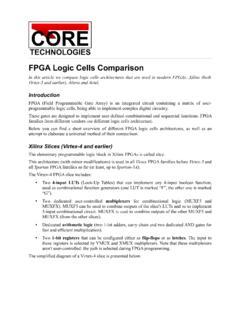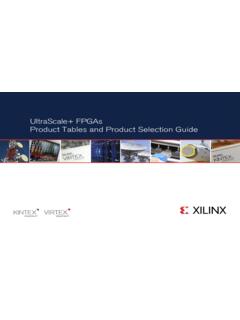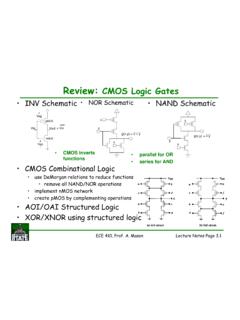Transcription of Chapter 4: Programmable Logic Devices 4.1 Chapter …
1 Chapter 4: Programmable Logic Devices Chapter Overview This Chapter provides an overview on Programmable Logic Devices (PLDs) form the history of Programmable Logic Devices to the device types. PLDs come in two forms, Complex Programmable Logic Devices (CPLDs) and Field Programmable Gate Arrays (FPGAs) both having their advantages and disadvantages with respect to the specific application or design they are to be used in. The PLD used for our design, which was a CPLD from Lattice Semiconductor is discussed. There is a need for design of smaller more dense electronic designs requiring less board space as well as less power in the space and military industries there are very few PLD vendors that provide Radiation Hardened components.
2 Unfortunately intellectual Property Cores will be discussed which is the latest trend for vendors to provide system-on-a-chip capability for their FPGA s. Introduction Background of Programmable Logic Devices A Programmable Logic device refers to any type of integrated circuit that a Logic design can be implemented and reconfigured in the field by the end user. Since these Logic Devices can be programmed in the field they are also called Field Programmable Logic Devices (FPLDs). The PLD provides flexibility for designers to implement many different designs in varying complexities for many different applications. One of the most common PLDs is the one time Programmable Read-only Memory (PROM).
3 This comes in two different types: (a) mask Programmable Devices programmed by the vendor using a custom mask and interconnects and (b) field Programmable Devices that are 16configured by the user. One of the great advantages of PLDs is that they are very inexpensive at low quantities. A device that was a follow on from the PROM technology that can be used for Logic designs was the Programmable Logic Array (PLA). The PLA using the PROM structure turned out to be the first Field Programmable Logic Array (FPLA). The first FPLA was introduced in the mid-1970s. The FPLA had a fixed number of inputs, outputs and product terms that consisted of AND and OR arrays that contained Programmable inputs.
4 The FPLA did not have great success because they were very slow and complicated to use. The designer had to design to a fuse map instead of conventional boolean equations or schematic capture. In the late 1970s the Programmable Array Logic (PAL) architecture was introduced that increased the use of Programmable Logic . The PAL architecture consisted of a Programmable AND array and a fixed OR array so that each output is the sum of a specific set of product terms. The design entry tool for the earlier PAL was in the form of Boolean equations making it very easy to learn and implement. PAL Devices are now available in different varieties from different vendors providing flexibility inputs/outputs, size of the OR-gate, and flip-flops.
5 Some PALs are even provided in either NAND/NAND or NOR/NOR structure to increase design flexibility instead of the AND/OR structure. PLDs can be divided into two groups, Simple Programmable Logic Devices (SPLDs) and High-Density Programmable Logic Devices (HDPLDs). SPLDs come in the PAL and PLA architecture, while HDPLDs include CPLDs and FPGAs. Figure 17contains a hierarchical block diagram of the PLD architectures, subfamilies and programming technologies. ProgrammableLogicDevices (PLDs)SimpleProgrammableLogicDevices (SPLDs)High-DensityProgrammableLogic Devices (HDPLDs)ProgrammableLogic Array(PLA)ProgrammableArray Logic (PAL)BipolarTechnologyCMOST echnologyComplexProgrammableLogic Devices (CPLDs)FieldProgrammableLogic Devices (FPGAs)SRAMP rogrammingAntifuseProgrammingEEPROM-CMOS T echnologyUVEPROM-CMOST echnology Figure PLD Hierarchical Architecture Simple Programmable Logic Devices The simple PAL architecture has become an industry standard.
6 PLAs and PALs that have pin packages of 20 44 pins and density ranging from 100 to several hundred gates are considered SPLDs. The Basic AND/OR architecture PALs are flexible Devices that can implement Logic equations in Boolean sum-of-product (SOP) form. Some enhancements to SPLDs have been Programmable input/outputs (I/Os), bidirectional I/Os, Programmable output polarity, flexible register configurations and chip clocks. 18 One important advantage for PLDs is that they can replace small to medium- scale integrated (SSI/MSI) circuits for higher packaging density. One PLD could replace tens of integrated circuits with 200 500 gate equivalent. Other benefits for SPLD is that they reduce power, have faster turn-around time, faster performance because they reduce interconnects between chips and higher reliability.
7 SPLDs are available in bipolar and Complementary Metal Oxide Semiconductor (CMOS) technology. In CMOS technology, they come in Erasable PROM (EPROM) based which are Ultraviolet Erasable (UVEPROM) and Electronically Erasable (EEPROM). Due to the simple architecture of an SPLD they offer very high performance. The SPLD Devices are at um CMOS process with Logic delays down to ns and frequencies as high as 200 MHz. Higher density Devices are coming on the market in the area of Complex Programmable Logic Devices (CPLD) with high performance, but SPLDs still have the best performance, easier to use and design with because they are an industry standard. Computer networking components and other telecommunication equipment still demand the need for SPLD Devices due their high performance.
8 Because of the trend to migrate to higher densities SPLDs have been driven to specialty markets such as cellular phones, video games and hand held web browsers. Table shows a comparison of SPLDs and CPLDs over a broad range of criteria. New innovative advancements in SPLD include Programmable output Logic , macrocells that can be configured as combinatorial or register operation and active low or active high polarity. SPLDs are also available in lower-voltage and low power offering 5 volt and volt Devices . This allows more flexibility for design applications that require trade-offs between low power, high frequency and low voltage. 19 Criteria SPLD CPLD Propagation Delay High Speed - Typically ns High Speed - Typically 10 ns Density 100 to Several Hundred Several Hundred to several Thousand (25,000 Gates) Technology Bipolar and CMOS CMOS Ease of Designing Very Easy Medium Ease Complexity Simple Architecture Medium to Difficult Architecture Frequency 200 MHz 100 MHz Programmable I/Os Yes Yes Table SPLD and CPLD Comparison High Density Programmable Logic Devices The main disadvantage for the SPLD is an architectural limitation.
9 SPLDs have a limited amount of Logic structures that can be allocated in a design in a fixed way. High-density or high-capacity PLDs (HDPLDs/HCPLDs), which are also called complex PLDs (CPLDs) and Field Programmable Gate Arrays (FPGAs), try to solve the silicon limitation by adding more flexible block structures and interconnects. Programmable Logic Devices include simple as well as high-density PLDs. In 1985 Xilinx Corporation came out with the first FPGA. It introduced the Logic Cell Array (LCA) and was the building block for all FPGAs to follow. It contained a pool of independent Logic cells and multiple routing resources that allowed any Logic cell to be connected to any other Logic cell.
10 This provided routing flexibility. The first LCA consisted of a combinatorial Logic function and a flip-flop. The I/Os could be programmed as input, output and bi-directional and the routing resources allowed for distributed clock through the chip, high speed and low-skew signals and local routing from LCA to LCA. 20 The two major elements of CPLDs and FPGAs are the Logic elements and the interconnect structure. The Logic elements are also known as macrocells, Logic cells and/or Logic blocks. The interconnect structure is how those elements are connected together to perform the design for a specific application. As mentioned there are two high-density Programmable Logic Devices .



















